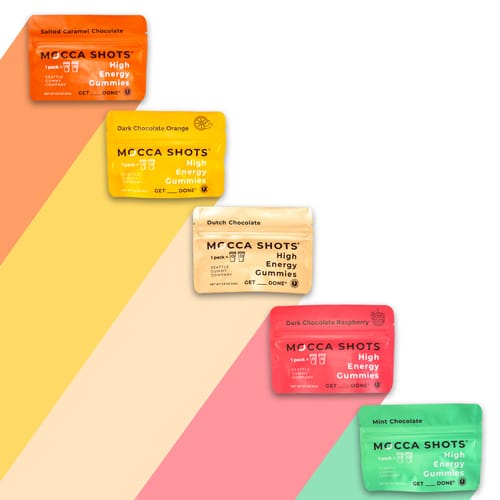Blog
What is Powerful Caffeine and It’s Benefit?
Caffeine is a powerful stimulant, capable of supporting the alertness needed to perform well at work and changing world history. Caffeine is the most popular stimulant in the world, used by over 90% of the world’s population. Most people associate caffeine with beverages like coffee and tea. Coffee and tea have shaped world history, from the coffee revolution in Britain, when beer was replaced with coffee as the all-day drink of choice, to the Boston tea party.
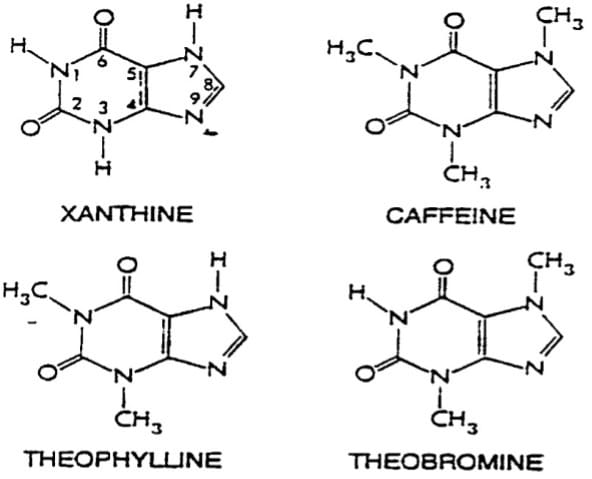
At its most basic state, caffeine is a white, odorless powder that may or may not contain one molecule of water, according to Dr. Abolfazl Aslani’s study on caffeine chewing gum. Because of its effects on the central nervous system, caffeine can cause many different responses depending on the person and their current state. By stimulating the release of adrenaline and by inhibiting chemicals in the body that cause sleepiness, caffeine can either help with alertness and focus or cause sleeplessness.
Another result of caffeine’s impact on the chemical that causes sleepiness, adenosine, is that those same chemicals tell our bodies to feel fatigued. The caffeine molecule is shaped like adenosine, and will “sit” on the adenosine receptors, blocking their ability to create feelings of fatigue. Caffeine also stimulates the respiratory system, making people not only breathe more but breathe deeper. Caffeine can also make you process information faster. These benefits make caffeine invaluable to many in the workforce. Caffeine also plays a role in overall safety, allowing fatigued drivers to drive safer, and helping people who work at night avoid accidents or costly errors. For example, truck drivers traditionally consume a lot of caffeine to make their drives safely.
It is especially important to be aware of your own body’s responses to caffeine and use it responsibly. This is one reason why it is good to try many different forms of caffeine to see how they work for you, so you can get the best results possible.
Now let’s talk about the different types of caffeine sources and how they’re absorbed by the body.
Liquid Caffeine: Hot vs Cold
Temperature affects caffeine’s solubility. Caffeine is more soluble in hot temperatures than in cold. Using coffee as an example, cold brew coffee is popular, but how is it different from hot coffee? Hot coffee and cold brew are made differently. For hot coffee, boiling water is poured over coffee grounds, and brewed for a few minutes, whereas with cold brew, cold water is poured over coffee grounds and then brewed for up to 8-12 hours. The hot water extracts more caffeine from coffee, so cold brew has a little less in it than hot coffee does, when made with the same amounts of water and coffee. However, cold brew coffee uses more coffee when brewing, than hot coffee, so that’s how cold brew generally has a higher caffeine content. Now, let’s talk about the new forms caffeine comes in, like the energy supplement or caffeine chew.
Energy chews: Liquid vs Solid Caffeine
Caffeine intake is no longer limited to coffee, tea, and energy drinks. There is a whole market of caffeine energy chews, which often offer more caffeine than coffee per chew. Seattle Gummy’s popular Mocca Shot contains caffeine equal to two cups of coffee. While beverages remain the most popular form for caffeine intake, liquids are not the most effective way to take caffeine.
When drinking coffee, tea, or an energy drink, the caffeine is absorbed through the small intestine. According to a study done on caffeine and Mental Task Performance for the military, liquid caffeine takes between 15 minutes and 2 hours to reach “peak plasma concentrations” (which means how much of the caffeine has been absorbed into the bloodstream). For some people, this may not be fast enough, particularly for those who are using caffeine to enhance workouts and athletic training.
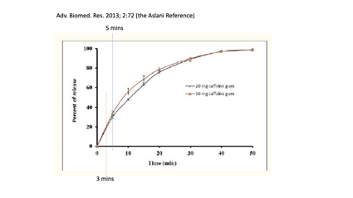
Compared to liquid caffeine, solid caffeine, from a piece of caffeine gum or an energy chew, is absorbed through the mucosal membranes in the mouth and is 20% absorbed within three minutes! As you can see on the graph from the Aslani study, the caffeine gum is fully absorbed within 50 minutes, making its absorption rate much faster than with liquid caffeine.
Caffeine boost: Which one absorbs the fastest?
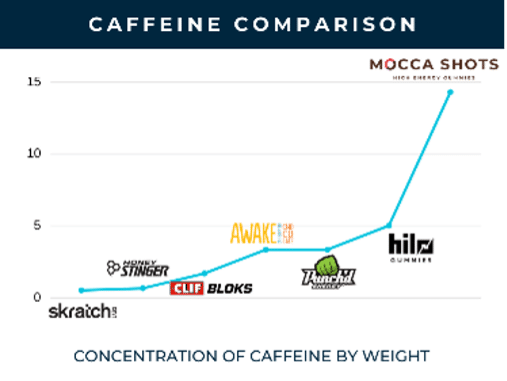
When it comes to absorption rates, science clearly shows that solid caffeine, in the form of a gum or a chew, is absorbed by the body more quickly than liquid caffeine. Also, with solid caffeine, more caffeine is absorbed at a higher speed, with 20% absorption in three minutes, compared to liquid caffeine starting to be absorbed at 15 minutes.
But which kind of solid caffeine is best? Energy chews are superior to gum because they are designed to be completely dissolved in the mouth, allowing for mucosal absorption. Caffeine chews, like Seattle Gummy’s Mocca Shots, absorb even quicker than the gum shown in the Aslani study, making them an efficient way to start the day or get an energy boost in the afternoon. Seattle Gummy’s wide range of energy shot gummies come in delicious flavors like Dark Chocolate Raspberry, Salted Carmel, and Mint Chocolate.
In addition to being in a more absorbable form, Seattle Gummy consistently beats out the competition when it comes to caffeine and calorie content. Seattle Gummy Mocca Shots have four times the amount of caffeine per calorie compared to energy drinks like Red Bull, Monster, and Starbucks coffee. That is a lot of calories avoided by choosing Mocca Shot!
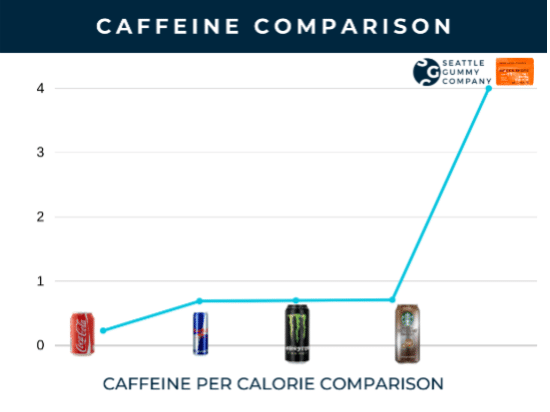
Seattle Gummy’s caffeine chews also have the highest concentration of caffeine by weight. This graph shows us that Seattle Gummy’s Mocca Shot not only outperforms other brands of energy chews, but it does so by a factor of at least ten. Choosing the high performance of Seattle Gummy’s energy gummies will help boost performance at every level, for any kind of task, whether it is in the workplace, or during a workout.

